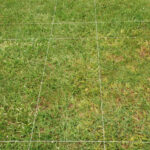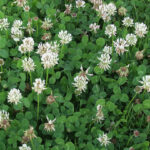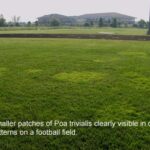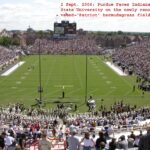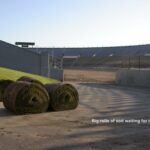Category: Athletic Fields
What’s it really cost to maintain an athletic field?
Whether you are maintaining a professional, university field or a local soccer field because your daughter is on the team, it is difficult to get an accurate estimate of the costs to maintain an athletic field. From my experience, we tend to dramatically underestimate the actual cost of maintaining athletic turf. Tom Samples and his […]
Regenerating Fall Use Athletic Fields
The end is near for Fall-use athletic fields, either literally or figuratively. With the recent wet weather, football and soccer fields have taken a beating. Don’t give up on these fields yet, because after the last game or practice is when you should work hardest to improve the field. Aggressive hollow-tine aerification, pulling 20 – […]
Tall fescue for Indiana lawns but not most sports fields
Tall fescue is a great turf for lawns throughout most of Indiana. It requires about ½ the nitrogen and far less irrigation than Kentucky bluegrass when managed for the same aesthetic appearance. Because of its deeper rooting and access to water in the soil, it stays greener than Kentucky bluegrass much longer into a drought. […]
Poa annua, Poa trivialis, and/or creeping bentgrass in lawns and sports fields
Poa annua (annual bluegrass), Poa trivialis (rough bluegrass) and creeping bentgrass are becoming common weeds in athletic fields and lawns. These weeds are important to distinguish because they require different controls. Poa annua: a winter annual that is lighter, more apple green than other lawn species. It is just past its aggressive seedhead stage, but you’ll likely still find […]
Dallisgrass healthy in southern IN
Dallisgrass has reemerged and is very healthy with the rain and warming temperatures. Dallisgrass is often mistaken for crabgrass but typical preemergence or post emergence crabgrass herbicides do not work on dallisgrass. MSMA is currently the standard control but that herbicide will not be available after 2010. Our current research is focusing on Syngenta’s Tenacity […]
White Clover in Golf Courses, Sports Turf, and Lawns
The small white flowers of white clover are very visible right now and it may appear that clover is taking over, especially under-fertilized turf areas. Clover is a legume and is very competitive under low N conditions, so increasing annual N is best method to help exclude this weed. However, its spreading stolons make it […]
Mowing height does not affect speed of athletes
We often hear the comment by coaches to change the mowing height of an athletic field when a particularly “fast” or “slow” team is coming to play. In a comprehensive article by Kevin Trotta in a June 16, 2004, “Turf News” article, he clearly showed that mowing height has little effect on player speed. Thought […]
Seeded bermudagrass or zoysiagrass is an option for some IN turf areas
In the southern third to of Indiana, seeded zoysia is a viable option for golf course fairway and tees, whereas seeded bermudagrass is an option for golf course fairways and athletic fields. A tremendous amount of recent research has been done on both of these species at Purdue as well as other universities. Our former […]
Ball mark Recovery: Does the Repair Tool Matter?
Putting green surface smoothness and uniformity is often disrupted by unrepaired ballmarks. These marks can disrupt surface smoothness and increase the potential for weed (e.g. annual bluegrass) encroachment. The traditional method for repairing ballmarks normally employs a metal pronged tool (≈ 1 in or 3 cm), or tee and using a knit and twist method […]
Regenerating Fall Use Athletic Fields
With the fairly wet weather last fall, football and soccer fields have taken a beating. The fields that were aggressively aerified, fertilized, and dormant-seeded last fall should improve dramatically by mid-May. Though improvement won’t be as efficient done now compared to the fall, there is still time to help a field if you missed out […]
White Clover in Golf Courses, Sports Turf, and Lawns
The small white flowers of white clover are very visible right now and it may appear that clover is taking over, especially under-fertilized turf areas. Clover is a legume and is very competitive under low N conditions, so increasing annual N is the best method for long-term control. The temptation is to apply a herbicide […]
Controlling Poa trivialis in sports fields
Poa trivialis is now common in sports fields, possibly due to as little as one contaminated seed source from the many overseedings done on sports fields. Once germinated, Poa trivialis spreads via stolons which may be further spread during every hollow tine aerification. Poa trivialis is shallow rooted, has poor wear resistance, is extremely susceptible to dollar spot, and often […]
Managing Surface Organic Matter in Bentgrass Putting Greens
As you begin planning for spring core cultivation, consider the following as some food for thought. Turf research has shown that excessive organic matter, and/or thatch (> ½ inch), in the upper (1-2 inches) rootzone profile can lead to rapid turf decline during stressful summer months. Excessive organic matter results in low soil oxygen, poor/shallow […]
Considering seeded zoysia for fairways?
The development of seeded zoysia will enable many more southern Indiana golf courses to enjoy the benefits of zoysia at reduced establishment costs. Benefits of zoysia include great playability during all four seasons, good winter tolerance, and low fertilization, irrigation, and pesticide requirements. These qualities make zoysia easily the best grass for transition zone fairways. […]
Little Time to Improve Athletic Turf This Year
Though weather this summer and fall wasn’t as bad as last year, we’ve still had our share of thin turf and fall events are taking their toll on the cool-season grasses. The perennial cause is the naturally shallow rooting of Kentucky bluegrass or perennial ryegrass at the same time that football and soccer seasons get […]
Helping Fall-use Athletic Fields
Fall use athletic fields are taking a beating right now. To help those fields, fertilizing aggressively with 1.0 lb N in September and again in October will help. Fertilizing is the most inexpensive but effective way to improve any sports field. Though it’s easier said than done, aerifying during extended breaks in practices or games […]
New Era begins for Ross-Ade stadium turf
The Purdue Boilermaker’s 60-35 win this past Saturday was not only the first test for the football program but also the first real test and a historic milestone for Purdue’s newly renovated field. The beginning of this season marks a new era in Purdue football as Ross-Ade stadium becomes the only Big-10 stadium with a […]
Summer stress of Poa annua, Poa trivialis on Golf Courses
Persistent air tempertatures of 90F and soil temperatures greater than 80F combine with high humidity and adequate rainfall (in some areas) is doing in the Poa annua (annual bluegrass)and Poa trivialis (rough bluegrass)on golf courses. After a week or two of these conditions, Poa annua greens and fairways will start to thin and die in […]
Summer stress of Poa annua and Poa trivialis in Lawns and Sports Fields
Persistent air temperatures of 90F and soil temperatures greater than 80F combine with high humidity and adequate rainfall (in some areas) is also doing in the Poa annua (annual bluegrass) and Poa trivialis (rough bluegrass)on lawns and athletic fields. Patches of these fine-bladed grasses seemingly die overnight with even a minimum of drought stress. Though […]
Bermudagrass Takes Root in Ross-Ade and the South Football Practice Field
It is in some ways difficult to believe that it has been just over one month since the first “Big Rolls” of ‘Patriot’ bermudagrass were installed in Ross-Ade stadium on 6 June, 2006. The sod 42” wide rolls arrived on refrigerated trucks from the sandy coastal plain soils of Eastern Maryland. Some of you may […]
